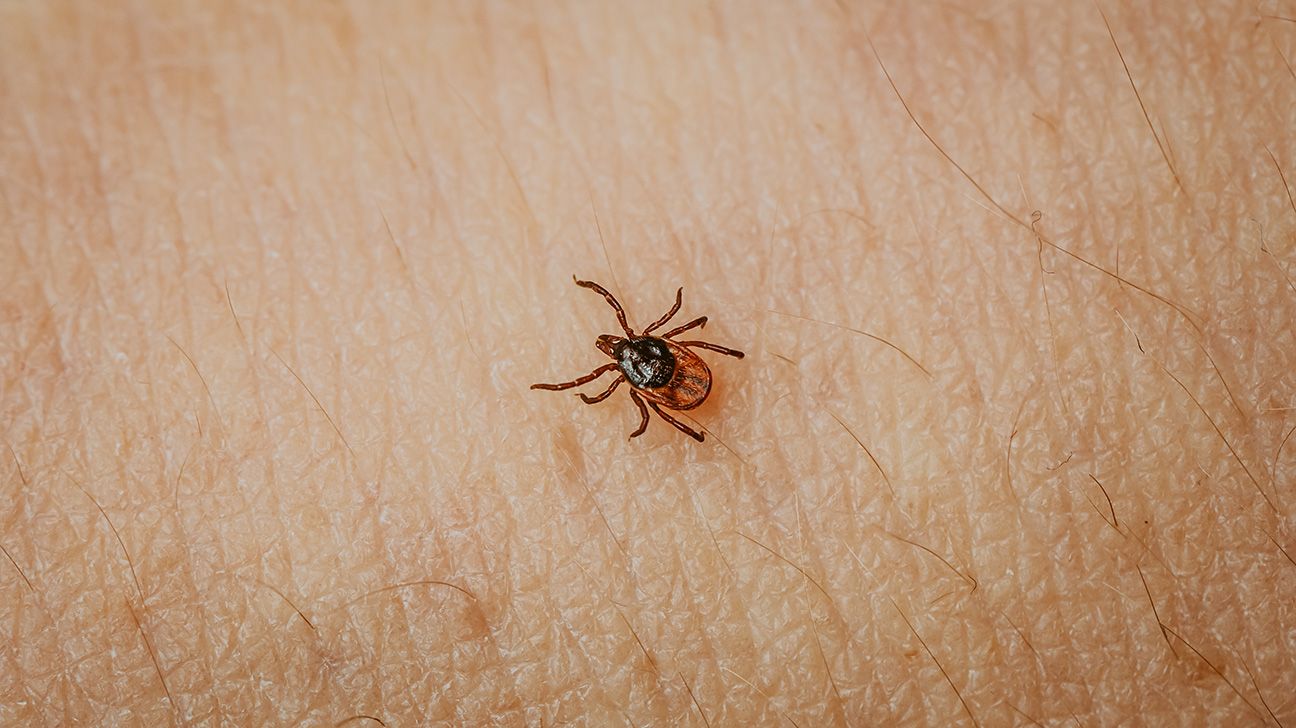
Lyme disease is a prevalent illness transmitted through the bite of infected ticks. It’s caused by the bacterium Borrelia burgdorferi and is most commonly found in wooded and grassy areas where these ticks thrive. Understanding the contagiousness of Lyme disease is crucial for prevention and treatment.
What is Lyme Disease?
Lyme disease is an infectious illness caused by the bacterium Borrelia burgdorferi. It was first identified in the town of Lyme, Connecticut, in 1975, hence its name. The disease primarily affects humans and other animals.
According to the Centers for Disease Control and Prevention (CDC)Trusted Source, infected ticks transmit Lyme disease in the Northeastern, Mid-Atlantic, and North Central United States, as well as on the Pacific Coast of the United States.
What Causes Lyme Disease?
Lyme disease is caused by the bacterium Borrelia burgdorferi, is a prevalent tick-borne illness that affects thousands of individuals annually. The disease is primarily transmitted through the bite of infected black-legged ticks, commonly known as deer ticks. Symptoms range from mild to severe and can affect various bodily systems, including the skin, joints, heart, and nervous system.
What Are the Symptoms of Lyme Disease?
Symptoms of Lyme disease usually start 3–30 daysTrusted Source after the tick bite. One of the earliest signs of the disease is a bull’s-eye rash, also known as an erythema migrans.
Up to 8 out of 10 peopleTrusted Source experience a bull’s eye rash, which occurs at the site of the tick bite. It usually has a central red spot surrounded by a clear spot with an area of redness at the edge.
People with lighter skin may have a rash that’s solid red, while people with darker skin may have a rash that resembles a bruise. It may be warm to the touch, but it’s not painful and doesn’t itch.
Other symptoms commonly seen in stage 1 of Lyme disease includeTrusted Source:
Early disseminated Lyme disease can appear up to 3 monthsTrusted Source after the tick bite, while late disseminated Lyme disease may take up to 12 months. Stages 2 and 3 of Lyme disease are characterized by systemic infection. This means the infection has spread throughout your body, including to other organs.
How is Lyme Disease Diagnosed?
Lyme Disease may be difficult to diagnose because many of the symptoms are similar to those of other conditions.
A healthcare professional will first perform a medical history and physical examination to look for erythema migrans and other symptoms characteristic of Lyme disease.
If you don’t have visual symptoms of Lyme disease, they’ll recommend a two-stepTrusted Source serology. This may include the following two blood tests to help detect antibodies:
It’s important to note that blood tests are most reliable only a few weeks after the initial infection. This is when antibodies are present.
Some at-home Lyme disease testing kits are also available. These may be beneficial if you’ve recently been bitten by a tick or you recently spent time in an area where ticks are common.
However, it’s best to see a doctor if you experience any signs or symptoms of Lyme disease.
How Does Lyme Disease Spreads?
The primary vector for Lyme disease is the black-legged tick, which becomes infected after feeding on small mammals or birds carrying the bacterium. When an infected tick bites a human, it can transmit the bacterium into the bloodstream, leading to infection.
Other Possible Modes of Transmission
While tick bites are the main mode of transmission, there have been rare cases of other potential transmission routes. These include transmission from mother to fetus during pregnancy, blood transfusions, or through contaminated needles.
Contagiousness of Lyme Disease
Understanding Contagiousness: Lyme disease itself is not contagious from person to person. It can only be transmitted through the bite of an infected tick.
Transmission Scenarios: While Lyme disease cannot be directly transmitted between individuals, there are instances where multiple people may become infected if they are bitten by infected ticks in the same area.
What Are The Preventive Measures?
Avoiding Tick Bites: Prevention is key when it comes to Lyme disease. Measures to avoid tick bites include wearing long sleeves and pants, using insect repellents containing DEET, and performing tick checks after spending time outdoors.
Protective Clothing: Wearing light-colored clothing can make it easier to spot ticks, and tucking pants into socks or boots can prevent ticks from reaching the skin.
Where To Get Tested?
Say Goodbye To Waiting Rooms And Long Lines. Speedy Sticks offers at-home testing.
Living with Lyme Disease
For individuals diagnosed with Lyme disease, managing symptoms and preventing recurrence are paramount. This may involve long-term antibiotic therapy, lifestyle modifications, and regular follow-up with healthcare providers.
Lyme disease symptoms in children
Children generally experience the same Lyme disease symptoms and progression as adults.
That said, a 2019 review suggests that you may also notice some psychological symptoms in your child, such as:
- anger or aggression
- mood changes
- depression
- nightmares
If your child seems to be acting differently and can’t explain why or what they’re feeling, speak with a doctor. These changes could be a sign of many conditions, including Lyme disease.
How is Lyme Disease Treated?
Treatment for Lyme disease will depend on the progression of the infection.
Early stages
Lyme disease is best treated in the early stages. Treatment for early localized disease is a 10- to 14-dayTrusted Source course of oral antibiotics to eliminate the infection.
Medications used to treat Lyme disease include:
Later stages
If Lyme disease has progressed beyond stage 1 or affects your circulatory or central nervous systems, a doctor may prescribe intravenous (IV) antibiotics. This will then be followed up with an oral regimen. The complete course of treatment usually takes 14–28 days.
If you experience abnormal heart rhythm or heart block, a doctor may also recommendTrusted Source you stay in the hospital to be monitored until the abnormality resolves.
Lyme arthritis, a late-stage symptom of Lyme disease, is also treated with oral antibiotics for 28 days.
How is Lyme Disease Transmitted?
The infected tick must be attached to your body for at least 36 hoursTrusted Source to transmit the bacterium.
Most Lyme disease infectious are caused by immature ticks, called nymphs. They feed during the spring and summer. Nymphs are more likely to transmit Lyme disease due to their sizeTrusted Source. They’re roughly the size of a poppy seed, which makes them harder to see and remove than adult ticks.
Is Lyme disease contagious?
There’s currently no evidence that Lyme disease is contagious between people, according to the CDC. This means it cannot be transmitted through touching, kissing, having sex, or air, food, and water.
What Are The Risk factors for Lyme Disease?
Living in a state with a high prevalence of Lyme disease may increase your risk of being bitten by an infected tick. According to the CDC, as of 2021, the U.S. states with the highest incidence of Lyme disease include:
- Connecticut
- Delaware
- Maine
- Maryland
- Massachusetts
- Minnesota
- New Hampshire
- New Jersey
- New York
- Pennsylvania
- Rhode Island
- Vermont
- Virginia
- West Virginia
- Wisconsin
People who work outdoors are also at an elevated riskTrusted Source of Lyme disease, including those who work in:
- construction
- landscaping
- forestry
- farming
- park or wildlife management
Most tick bites happen in the summer when ticks are most active and people spend more time outside.
However, it’s possible to get Lyme disease from tick bites in early fall, and even in late winter if the weather is unseasonably warm.
Can I prevent Lyme disease?
Yes, you can prevent Lyme disease by protecting yourself from ticks. This is because the infection is transmitted through bites from infected ticks.
How can I prevent tick bites?
Some ways to prevent tick bites may includeTrusted Source:
- wearing long pants and long-sleeve shirts when outdoors
- protecting your clothing with permethrin
- using insect repellents, such as DEET products
- using natural insect repellants, such as oil of lemon eucalyptus
- checking yourself and your pets after being outside in areas with brush, long grass, and wood
How do I spot a tick?
Checking yourself for ticks in the shower or bath is important after you’ve come in from outside.
Other than that, check your clothes, especially the folds of your clothes, knowing that ticks can be very small and hard to spot. Running your hands through your hair is also a good idea.
What should I do if a tick bites me?
If a tick bites you, it’s important to remove it as soon as possible.
According to the CDC, the best way to remove a tick is to:
- Use a pair of tweezers to grab the tick.
- Steadily pull upward, being careful not to twist the tweezers (this may cause the mouth parts of the tick to break off and stay stuck in the skin).
- After removing the tick, clean the bite area with soap and water, or rubbing alcohol.
- Don’t crush the tick. Dispose of it by putting it in alcohol, flushing it down the toilet, or putting it in a sealed bag and in the trash.
What is the outlook for someone with Lyme disease?
The majority of people who receive a diagnosis of Lyme disease will recover within 2–4 weeks of starting treatment, according to the CDC.
However, approximately 5–10%Trusted Source of people with Lyme disease will experience post-Lyme disease syndrome, also known as chronic Lyme disease.
Symptoms of post-Lyme disease syndrome are similar to those that occur in the earlier stages of the condition, such as:
- fatigue
- difficulty sleeping
- aching joints or muscles
- pain or swelling in your large joints, such as your knees, shoulders, or elbows
- difficulty concentrating and short-term memory problems
- speech problems
Treatment is primarily focused on easing pain and discomfort. Most people recover, but it can take months or years.
In most cases, Lyme disease can go away with early diagnosis and treatment. However, if you start treatment in the later stages, you may experience long-term complications like damage to your joints.
Can you live a normal life with Lyme disease?
Most people can live a normal life after receiving treatment for Lyme disease. However, up to 10%Trusted Source of people experience chronic symptoms of Lyme disease that could affect mobility and cognitive skills.
What happens when Lyme disease goes untreated?
If left untreated, Lyme disease may progress and cause serious neurological and rheumatoid complications. These may include facial palsy, extreme fatigue, meningitis, and arthritis, among others. It’s important to get treated as early as possible if you have Lyme disease.
Can you recover from Lyme on your own?
Antibiotics are needed to treat Lyme disease. Left untreated, the infection can progressively get worse and lead to more serious long-term complications.
Conclusion
Lyme disease is a significant health concern caused by the bacterium Borrelia burgdorferi and transmitted through the bite of infected ticks. While the disease itself is not contagious from person to person, prevention remains crucial through measures such as avoiding tick bites and seeking prompt treatment for symptoms.
Importantly, raising awareness about Lyme disease, its symptoms, and preventive measures is essential in combating its spread and ensuring early diagnosis and treatmen
Say Goodbye To Waiting Rooms And Long Lines. Speedy Sticks offers at-home testing.










Recent Comments